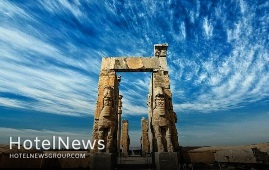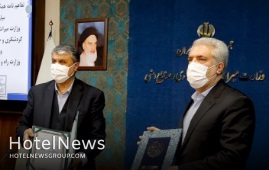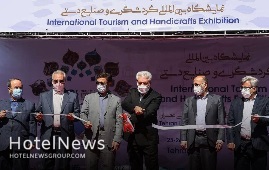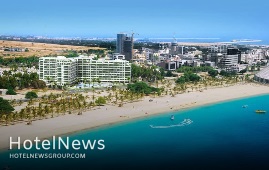
Iran will set aside ten billion rials (some $240,000 at the official exchange rate of 42,000 rials per dollar) for the restoration of the Great Wall of Gorgan, Cultural Heritage, Tourism and Handicrafts Minister Ali-Asghar Mounesan said on Sunday. Situated in the city of Gorgan, the capital of northern Golestan province, the defensive wall is about 200 km in length, and it was built to prevent the invasion of the northern tribes. It is said to be the longest architectural work of ancient Iran, which was built in 90 years. “We will allocate one billion tomans (ten billion rials) of credit for the restoration of the Great Wall of Gorgan, so that with this credit, the measures for the restoration of this wall, along with aerial imaging and mapping, will be carried out as preliminaries for [the possible] UNESCO registration,” Mounesan said. The minister made the remarks in a meeting with provincial officials and cultural figures during his visit to the lush green province. Last December, Mounesan’s deputy for cultural heritage, Mohammad-Hassan Talebian, said: “Gaining a UNESCO tag for the Great Wall of Gorgan -- one of the longest brick barriers of the ancient world -- is not hard as it is comparable to the Great Wall of China in terms of age, function, and size.” Although there are some issues and obstacles, further efforts to preserve and restore the millennia-old wall could be an acceptable justification for UNESCO to add this structure to the World Heritage list, Talebian explained. To get to that point, complete and accurate mapping of the remnants of the wall is needed, for which a budget of 20 billion rials ($476,000 at the official rate of 42,000 rials) has been allocated so far official added. He also noted that if the mapping project comes to an end by the end of the current Iranian year 1399 (March 20, 2021), the inscription of the wall on the World Heritage list would be discussed and possibly approved by the end of the next summer. Also known as Red Wall, which in some ancient texts is referred to as the Red Snake, this wall is the longest brick ancient barrier between Central Europe and China, longer than Hadrian’s Wall and the Antonine Wall put together and the third-largest wall in the world after the walls of China and Germany. Most parts of the gigantic monument are still hidden underneath the surface through some segments that have so far been unearthed and even restored to former glory. Archaeological excavations have so far identified ditches, brick kilns, earthen dams, water canals, 38 forts, and watchtowers attached to the wall, and more than 25 castles in the southern margin of the wall as well as several ancient sites from prehistoric, historic, and Islamic eras. The gigantic barrier is also more than three times the length of the longest late Roman defensive wall built from scratch, the Anastasian Wall west of Constantinople. The combined area of the forts on the Gorgan Wall exceeds that of those on Hadrian’s Wall about threefold. According to UNESCO, the Gorgan Wall is remarkable not only in terms of its physical scale but even more so in terms of its technical sophistication. To enable construction works, canals had to be dug along the course of the defensive barrier to provide the water needed for brick production. These canals received their water from supplier canals, which bridged the Gorgan River via qanats. One of these, the Sadd-e Garkaz, survives to 700 m in length and 20 m in height but was originally almost one kilometer long. The Gorgan Wall and its associated ancient military monuments provide a unique testimony to the engineering skills and military organization of the Sassanian Empire. They help to explain its geographic extent, from Mesopotamia to the west of the Indian Subcontinent, and how effective border defense contributed to the Empire’s prosperity in the interior and its longevity. These monuments are, in terms of their scale, historical importance, and sophistication, of global significance. Golestan is reportedly embracing some 2,500 historical and natural sites, with UNESCO-registered Gonbad-e Qabus – a one-millennium-old brick tower – amongst its most famous.
Create: Mar 9, 2021 Edit: Mar 9, 2021 Regional News
The new Austin Marriott Downtown opens today, steps away from the most popular downtown tourist attractions, bars and restaurants. The hotel represents the newest design vision for Marriott Hotels, the signature brand of Marriott International, where spaces and amenities are crafted to allow guests to achieve moments of creative brilliance.The 31-story stylishly-designed tower fits seamlessly into the Austin skyline and speaks to the needs of today’s modern traveler, including hand-crafted food and beverage offerings, advanced health and safety features, and plenty of outdoor and socially distant options for connecting with others.Guests will feel a sense of place the moment they walk in the door, whether they’re in town for a staycation, weekend getaway, business trip, meeting or convention. The hotel’s design is inspired by its home city, with limestone and Texas Cedar native to central Texas used throughout the hotel.Guest rooms start on level seven to maximize views of Lady Bird Lake, the University of Texas campus, the city skyline, and in the distance, Texas Hill Country. Of the 613 guest rooms the hotel offers 25 luxurious suites. The reimagined rooms offer a spacious and elevated look complete with tailored solutions that are as inventive as its guests.Based on consumer insights, locally-inspired accents offer a sense of place, and the work surface provides flexibility to freely move and use technology wherever the guest desires. Deluxe walk-in showers and spa-like lighting complete the relaxed experience throughout the room.Hand-Crafted Food and DrinksFrom top to bottom, Austin Marriott Downtown’s restaurants and bars are sure to be new local favorites.Zanzibar. Seven stories up and a world away. Zanzibar, a lush tropical rooftop terrace and pool oasis with stunning views of downtown, opened before the hotel in September 2020. It quickly became a popular spot among Austin locals and travelers alike, known as a socially distant outdoor rooftop where guests can escape the everyday with modern tiki cocktails. It features its own street-level elevator access on San Jacinto Boulevard to transport you seven stories up and a world away.Zanzibar’s menu features modern tiki cocktails and island-inspired small plates. Specialty drinks are influenced with exotic spices grown right in Zanzibar, including cinnamon, nutmeg, vanilla and clove. Zanzibar is known as ‘spice island’ and was once the largest exporter of spices in the world so the drink and food menus reflect Zanzibar’s unique sense of place and flavors.Corinne Restaurant. Honest food + drink. Featuring one of the largest outdoor patios on West Cesar Chavez Street, Corinne is an honest and fresh neighborhood dining and cocktail spot serving classic, authentic regional classics and American comfort food with an emphasis on signature rotisserie dishes.From the featured Rotisserie Chicken dusted with mustard, thyme and lemon, to the Truffled Bucatini or the Wagyu Beef Tartare, lunch and dinner are complete with variety only available at Corinne. This is the second Corinne location following the first that opened in Denver in 2017.The Lobbyist. The Lobbyist is not only a clever nod to Austin’s history as a capital city, but it will also provide locals and hotel guests alike with a place to pause and reset or reach for a nightcap as they plan their next adventure. With a grand staircase entry, The Lobbyist is a two-story cocktail bar with a mezzanine level overlooking the entire hotel lobby with floor-to-ceiling windows to the outside.Loaf + Vine. Loaf + Vine is a modern urban grocer with a broad selection of quick and freshly made meals, grab-and-go options, fresh bakery goods, and cold drinks and coffee beverages. Available daily is everything from fine wines and craft beer to artisanal local favorites.60,000 Square Feet of Meeting Flexibility Meeting planners have a lot to celebrate about with Austin Marriott Downtown’s Next Gen Meeting Space that is tailored around any needs – from socially distanced setups to large gathering options. The hotel offers an 18,000 square foot exhibit hall filled with light thanks to a 204-foot wall of floor-to-ceiling windows, as well as two 14,000 square foot ballrooms. The hotel follows all of Marriott International’s Connect with Confidence best practices for meetings and events.“This hotel is where Austin’s individuality meets the spirit of Texas,” said David Meisner, General Manager of the Austin Marriott Downtown. “With our state-of-the-art meetings facilities, wide selection of food and beverage outlets and thoughtfully-appointed guestrooms guests can reach their full creative potential. We are ready to be the first to safely welcome so many back to this great city as travel regains its footing.”“At Marriott Hotels, we want our guests to experience forward-thinking, aesthetically pleasing spaces that help foster their inventive nature and allow them to get into their best headspace for success,” said Manny Rappenecker, Vice President, Marriott Hotels. “We are so excited to extend the footprint of our brand in Austin, a city known for its innovative and creative spirit. We hope guests at Austin Marriott Downtown will be able to free themselves of distractions when they step into our hotel, allowing them to focus solely on being the best they can be.”Austin Marriott Downtown offers a completely touchless check-in and check-out experience, as well as elevator and in-room television controls using a personal smartphone. Austin Marriott Downtown is following Marriott International’s Commitment to Clean protocols, created in partnership with leading experts in food and water safety, hygiene and infection prevention, and hotel operations. These protocols include mandated mask wearing for all guests and associates within the hotel, and the use of disinfectants recommended by the Centers for Disease Control and the World Health Organization to sanitize surfaces in the hotels.The Austin Marriott Downtown is owned and operated by White Lodging. White Lodging currently owns and/or manages more than 4,000 guest rooms and 10 restaurants and bars in downtown Austin, including the Moxy Austin-University, which opened in January 2021 as the only one of its brand in Texas.
Create: Mar 6, 2021 Edit: Mar 7, 2021 International News
An archaeological discovery lately been made in the vicinity of Persepolis has shed new light on the once ceremonial capital of the Achaemenid empire. Excavations and surveys on Tall-e-Ajori, which is situated in the surrounding areas of the UNESCO-registered Persepolis, are expected to help archaeologists uncover more about the history of the royal city. Regarding the significance of such excavations around Persepolis, the director of the World Heritage site on Wednesday noted: “[Some] half of the ancient world was led and managed from the Persepolis.” There is ample evidence for the claim, which could be found across the Marvdasht plain, which is also home to the UNESCO-registered Pasargadae, and several historical sites as well as villages and small towns scattered in an area of 85,000 hectares around Persepolis, Hamid Fadaei added. However, protecting and preserving such a vast area would be a challenging and time-consuming task, he explained. The official also noted that besides the archeological significance, the ecosystem and natural resources, and capacities of the area should be taken into consideration. Supervised by a joint mission of Iranian and Italian archaeologists and cultural heritage experts, the excavations on Tall-e-Ajori uncovered vestiges of a massive gateway measuring 30 by 40 meters with a height of approximately 12 meters. The archaeologists succeeded in proving that Cyrus had ordered the construction of the gateway near Persepolis in Tall-e-Ajori and that this magnificent gateway had been put into operation during the reign of his son Cambyses. “The building had a corridor in the center, which was in form of a rectangular room measuring eight by twelve meters, and inside this central room, there were four living chairs. And the central corridor opened on both sides to the Achaemenid campus,” according to Alireza Askari-Charoudi who is a senior Iranian archaeologist. The royal city of Persepolis ranks among the archaeological sites which have no equivalent, considering its unique architecture, urban planning, construction technology, and art. Persepolis, also known as Takht-e Jamshid, whose magnificent ruins rest at the foot of Kuh-e Rahmat (Mountain of Mercy) is situated 60 kilometers northeast of the city of Shiraz in Fars province. The city was burnt by Alexander the Great in 330 BC apparently as revenge to the Persians because it seems the Persian King Xerxes had burnt the Greek City of Athens around 150 years earlier. The city’s immense terrace was begun about 518 BC by Darius the Great, the Achaemenid Empire’s king. On this terrace, successive kings erected a series of architecturally stunning palatial buildings, among them the massive Apadana palace and the Throne Hall (“Hundred-Column Hall”). This 13-ha ensemble of majestic approaches, monumental stairways, throne rooms (Apadana), reception rooms, and dependencies is classified among the world’s greatest archaeological sites. Persepolis was the seat of the government of the Achaemenid Empire, though it was designed primarily to be a showplace and spectacular center for the receptions and festivals of the kings and their empire. The site is marked by a large terrace with its east side abutting the Kuh-e Rahmat (“Mount of Mercy”). The other three sides are formed by a retaining wall, varying in height with the slope of the ground from 13 to 41 feet (4 to 12 meters); on the west side, a magnificent double stair in two flights of 111 short stone steps leads to the top. On the terrace are the ruins of several colossal buildings, all constructed of a dark gray stone (often polished to a marble-like surface) from the adjacent mountain. According to Britannica, the stone was cut with the utmost precision into blocks of great size, which were laid without mortar; many of them are still in place. Especially striking are the huge columns, 13 of which still stand in the audience hall of Darius I (the Great; reigned 522–486 BC), known as the Apadana, the name given to a similar hall built by Darius at Susa. There are two more columns still standing in the entrance hall of the Gate of Xerxes, and a third has been assembled there from its broken pieces. In 1933 two sets of gold and silver plates recording in the three forms of cuneiform—ancient Persian, Elamite, and Babylonian—the boundaries of the Persian empire were discovered in the foundations of Darius’s hall of audience. Several inscriptions, cut in stone, of Darius I, Xerxes I, and Artaxerxes III indicate to which monarch the various buildings were attributed.
Create: Mar 6, 2021 Edit: Mar 6, 2021 Regional News
On Sunday, Mohammad Hassan Zibakhsh, the spokesman of Iran's Civil Aviation Organization (CAO), announced that all flights to and from 32 countries have been suspended due to the latest decision of the National Headquarters for Coronavirus Control, IRIB reported. The new restrictions also limit travels between the Islamic Republic and England, Angola, Bolivia, Botswana, Burundi, Cape Verde, Chile, Colombia, Democratic Republic of the Congo, Ecuador, Eswatini, French Guinea, Lesotho, Guyana, Malawi, Mauritania, Mauritania, Rwanda, Sicily, Suriname, Tanzania, Uruguay, Venezuela, and Zambia. Regarding the admission status of travelers from countries with special conditions, the official said: “For direct or indirect flights to Iran, passengers, who have stayed in one of the cited countries for more than four hours within a maximum of two weeks before the date of travel, will not be able to enter the Islamic Republic of Iran until further notice.” Earlier this month, Iran announced it would reduce the validity of negative COVID-19 PCR test results from 96 hours to 72 hours for inbound and outbound passengers. The new regulation replaced a role that required to bar passengers from boarding if they do not have a negative COVID test within 96 hours of departure. All passengers are subject to the medical screening on arrival, and if they are suspected of having the disease, non-Iranian nationalities will be quarantined at a place specified by the Health Ministry at their own expense and Iranian citizens will need to self-isolate for 14 days. The worldwide outbreak of COVID-19 has brought the world to a standstill, and tourism has been the worst affected of all major economic sectors. World tourist arrivals fell by 72% over the first ten months of 2020, according to data compiled by the World Tourism Organization (UNWTO) in December. Restrictions on travel, low consumer confidence, and a global struggle to contain the coronavirus pandemic are amongst factors contributing to the worst year on record in the history of tourism. Iran has also suffered the same fate as its foreign arrivals plunged 72% during the first eight months of 2020 when compared to 2019.
Create: Mar 2, 2021 Edit: Mar 2, 2021 Regional News
Cultural Heritage, Tourism, and Handicrafts Minister Ali-Asghar Mounesan on Sunday signed a memorandum of understanding (MOU) with Transport and Urban Development Minister Mohammad Eslami to deepen cooperation and expand bilateral ties. The MOU aims at developing maritime tourism and make the best use of its potential in the southern and northern coasts of the country, according to a press release issued by the tourism ministry. Promoting the culture of using the sea as a tool to increase social vitality, development of coastal activities in the form of environmentally-friendly plans and programs, and creating the necessary grounds for cooperation and exchange of knowledge and information were also among the topics of the agreement. The traditional skills of building and sailing Iranian Lenj boats in the Persian Gulf was another issue discussed by the two ministers to find a way to safeguard the endangered UNESCO-registered tradition for future generations. Speaking on the sidelines of the signing ceremony, Mounesan said that the tourism ministry tries its best to leave single product tourism behind and diversify tourism products. A focus on the country’s natural capacities along with the historical and cultural capacities could attract more domestic and foreign tourists as well as create more job opportunities in some deprived areas, he explained. He also expressed hope that constructing seaside hotels on the northern and southern coasts and bringing the international cruise ships would also boost maritime tourism in the country. For his part, Eslami said that having a well-organized program for the development of beaches and the use of marine recreation is a priority for the transport ministry. Over the past couple of years, the Islamic Republic has made various efforts to exploit maritime tourism potential by developing hospitality infrastructures, diversifying sea routes, and drawing private sector investors along its vast southern coasts. Prosperous maritime tourism could help the county to meet its ambitious target of attracting 20 million annual tourists by 2025. It also keeps an eye on tourism developments in the Caspian Sea in the north.
Create: Mar 2, 2021 Edit: Mar 2, 2021 Regional News
Iran’s Cultural Heritage, Tourism and Handicrafts Ministry has gained official permission for organizing limited intercity travels during the Iran New Year vacations, which begins on March 21. “We have obtained permission for limited Noruz trips from the National Headquarters for Coronavirus Control,” the deputy tourism minister, Vali Teymouri, announced on Tuesday. With less than a month to go till the start of the Iranian New Year, which has long been associated with millions of domestic travels, the ministry wants to find a way to partially revive the already-slumped travels in the face of the COVID-19 pandemic. “The tourism ministry has held several meetings with the National Headquarters for the Coronavirus Control during with we discussed the issues in detail. Based on our strategies, we proposed two travel models that can be implemented following health protocols in the country,” Teymouri said last week. The first [working] model for travels in the Iranian New Year, proposes travels by the means of package tours. “Throughout package tours, travelers benefit from services provided by the tour and they will stay in authorized accommodation centers [and destinations] which are under the supervision of the Ministry of Cultural Heritage, Tourism and Handicrafts,” the official explained. For the second model, people do not go on tours, but when traveling to their destination city, they must stay in authorized accommodation centers, which are under the supervision of the ministry, to comply with all health protocols and maintain public health, Teymouri stated. Any other form of accommodation would be prohibited to curb the virus, he said. “To help prevent the spread of the coronavirus in Noruz 1400, the establishment of tourist camps, camping, tourists staying in places such as schools, shrines, husseiniyahs, etc. is prohibited, and this issue has been announced to the provincial governors.” The arteria of Noruz travels is expected to be announced in detail during the upcoming exhibition for tourism and handicrafts, which will be held in near future, according to the official. The tourism minister, Ali-Asghar Mounesan, publicized in November that mass, unplanned travels are not approved. “The outbreak of the coronavirus has caused damage to the tourism industry in Iran and [other parts of] the world in such a way that according to statistics, 50 million people are directly and indirectly exposed to unemployment due to the virus spread in the global scene…. yet, mass or unplanned and irresponsible travels are not approved to take place during the coronavirus era.” Smart and responsible traveling should replace "do not travel” recommendations, the minister stressed, adding: “In our country, Corona has caused problems in the tourism industry and the worrying point is the continuation of this trend.” “We are well aware of what the National Headquarters for Coronavirus Control proclaims [the health protocols], hence as a proposal, we have formulated some smart, responsible travel packages by the implementation of which we could have secure travels,” the minister said. He has repeatedly announced that his ministry is in full coordination with the Ministry of Health for strictly implementing health protocols in travel destinations, hospitably centers, and museums, amongst others, underlining that “people’s health is our priority.” Iranians traditionally make hundreds of thousands of domestic trips during the New Year holidays, when most businesses and workplaces are closed, as are schools.
Create: Feb 24, 2021 Edit: Feb 24, 2021 Regional News
Tehran’s international tourism and handicrafts fair opened to the public on Tuesday in defiance of a government campaign to improve the hugely-battered travel sector in the face of the novel coronavirus. Cultural Heritage, Tourism, and Handicrafts Minister Ali-Asghar Mounesan and his deputies for tourism, and handicrafts were amongst attendees to the opening ceremony of the fair, which is underway at Tehran Permanent International Fairgrounds. Activists, including tour operators, hoteliers, transport businesses, and tour guides, are hopeful that such days would be numbered at the COVID-19 vaccine is getting more widespread. Since it first surfaced late in 2019, the pandemic has created a greater demand for experiences away from crowds, which is opposite to many traveling pillars. Experts say that such preference for solo travel would probably continue till a coronavirus vaccine is ever-present. “Safe and Responsible Travels” has been picked as the motto of the four-day event that according to organizers could help boost synergy among the two sectors as people have a chance to visit them maybe in a day-long visit! The event is being held according to health protocols announced by the National Headquarters for Coronavirus Control, and following the necessary coordination with the relevant agencies in this field, according to Vali Teymouri, the deputy minister for tourism. Travel agencies, airlines, sea or rail companies, entrepreneurs, startups, banks, insurance brokers, agents or hospitals in charge of health, medical tourism, sports clubs, pilgrimage & eco-tourism companies, representatives of hotels, guesthouses, touristic villages, and free zones are amongst exhibitors in the tourism sector. Furthermore, tens of booths and stands in various exhibition halls have been dedicated to craftspeople, artisans, live performers, and tribespeople who are coming together from every corner of the ancient land to promote skills inherited from generation to generation. Though its main goal of the sales exhibit is to make money and sails of the handicrafts, souvenirs, foodstuff, and various other regional products, it can be a venue for dialogue between exhibitors and visitors and even visiting officials, according to organizers. The fair showcase arrays of personal ornamentation, woodwork, illuminated manuscript, miniature, textile printing, enamel, leatherwork, handwoven textile, calligraphy, traditional musical instrument, metalwork, and marquetry among tens of others while nomadic culinary arts, live workshops, and performances that would gather own fans every corner. Iran expects to reap a bonanza from its numerous tourist spots such as bazaars, museums, mosques, bridges, bathhouses, madrasas, mausoleums, churches, towers, and mansions, of which 24 being inscribed on the UNESCO World Heritage list. Under the 2025 Tourism Vision Plan, it aims to increase the number of tourist arrivals from 4.8 million in 2014 to 20 million in 2025. So it will undeniably try its best to achieve a relatively ambitious goal but when that happens the travel industry is likely to look more altered.
Create: Feb 24, 2021 Edit: Feb 24, 2021 Regional News
Iranian tourism minister Ali-Asghar Mounesan and his deputy for handicrafts, Pouya Mahmoudian, honored some exemplary crafters and artisans on Saturday. Behruz Zarindashti in ceramic and Sara Hedayat in costume designing received Silver Cypress, during the closing ceremony of the 5th Fajr national handicrafts festival, one of Iran’s major crafts shows held in the National Museum of Iran. Furthermore, Zeinab Masudi in illumination, Abbas Jalalikia in woodwork, Saru Moqerchian in metalwork, and Vajiheh Sadat Jalali in woodcarving received honorable mentions, according to organizers. Two the recently-deceased veteran crafters; Ahmad Shishegar, who was a master of tilework, and Amir Saeim, a master of toreutics, were honored posthumously during the ceremony, which was attended by tens of artists, crafters, and cultural officials as well. Over 150 crafters practicing different fields of handicrafts participated in this edition of the festival, of which several were honored during the ceremony. This edition of the festival, which brings together works from all over the country and is a venue for showcasing tens of ancient and modern Iranian handicrafts, was held entirely online due to the coronavirus outbreak. The event showcased woodwork, illuminated manuscript, miniature, textile printing, enamel, leatherwork, calligraphy, metalwork, mirrorwork, and marquetry, among others. It also featured potteries, ceramics, personal ornamentation, rugs, and kilim carpets. With 14 entries, Iran ranks first globally for the number of cities and villages registered by the World Crafts Council, as China with seven entries, Chile with four, and India with three ones come next. In January 2020, the cities of Shiraz, Malayer, and Zanjan and the village of Qassemabad were designated by the WCC- Asia Pacific Region, putting Iran’s number of world crafts cities and villages from ten to 14. Shiraz was named a “world city of [diverse] handicrafts”. Malayer was made a global hub for woodcarving and carved-wood furniture. Zanjan gained the title of a “world city of filigree”. And Qassemabad village, which is nationally known for its traditional costumes, was also promoted to a world hub of handicrafts. Chador Shab, a kind of homemade outer-garment for women, was, however, the main subject for the WCC assessment for the village. Iran exported $523 million worth of handicrafts during the calendar year 1398 (ended March 19, 2020). Of the figure, some $273 million worth of handicrafts were exported officially through customs, and about $250 million was earned via suitcase trade (allowed for customs-free and tax-free transfer) through various provinces, according to data provided by the Ministry of Cultural Heritage, Tourism and Handicrafts. Ceramics, pottery vessels, handwoven cloths as well as personal ornamentations with precious and semi-precious gemstones are traditionally exported to Iraq, Afghanistan, Germany, the U.S., the UK, and other countries.
Create: Feb 22, 2021 Edit: Feb 22, 2021 Regional News
The country’s largest beach park is planned to be established in the Persian Gulf island of Kish, southern Iran. Hundreds of hectares of coastal lands on Kish Island have been ratified to be turned into a beach park, which would be the largest of its kind in the country, the CEO of Kish Civil, Water, and Urban Services Abolfazl Tayyebi said on Saturday. One of [public] benefits from the implementation of this project is that some 388,000 square meters of valuable beaches will not be ceded to the private sector, the official added. In many cities and countries of the world, nowadays, most of the beaches are owned by individuals and the private sector, and due to construction near the sea, they are out of reach of people and tourists, the official explained. With such a project and establishing facilities for the public on the island’s coastline, no one could encroach on this precious treasure that belongs to all Iranians, he noted. Amongst the Persian Gulf islands, Kish is the more luxurious and developed. Except for its unique nature such as waters and shallow beaches, the tourist attractions of this charming island are due to its rich historical background as well as kind and hospitable people. About one million foreign and domestic tourists travel to the island every year and it is one of the most popular tourist destinations in Iran as it has magnificent attractions such as Kariz Underground City, Harireh Ancient City, Greek Ship, and Grand Recreational Pier to name a few.
Create: Feb 21, 2021 Edit: Feb 21, 2021 Regional News
Cambria Hotels, an upscale brand franchised by Choice Hotels International, Inc. (NYSE: CHH), continues to expand in key markets across the country with the opening of its newest downtown location: the Cambria Hotel Washington D.C. Capitol Riverfront. The nine-story, 154-room hotel is the brand’s fifth property in the greater Washington, D.C. area, among Cambria hotels in College Park, Maryland; Rockville, Maryland; Arundel Mills, Maryland; and in D.C. near the Convention Center. The hotel also marks the brand’s expansion in the D.C. and Maryland region, with six properties now open including in Ocean City, one of the most popular beach and vacation destinations on the east coast. Located at 69 Q Street SW, the Cambria Hotel Washington D.C. Capitol Riverfront is situated in the heart of the District’s growing Capitol Riverfront neighborhood. The hotel provides travelers with picturesque views of the Potomac River and convenient access to nearby attractions, including The Wharf, which features concert venues, restaurants and local shops; Nationals Park; the Yards Marina, and the new Audi Field soccer stadium. The hotel is also within three miles of the U.S. Capitol, Fort McNair and the National Mall, and just a short walk to the Navy Yard Metro Station, which connects guests to destinations in Washington, D.C., Maryland and Northern Virginia. “For Choice Hotels, along with many of our collaborators on this project, this area is our home, so we’re especially proud to continue our expansion in the region and support the community we love with the opening of yet another Cambria hotel,” said Janis Cannon, senior vice president, upscale brands, Choice Hotels. “Like all Cambria properties, the Cambria Hotel Washington D.C. Capitol Riverfront is designed to ‘wow’ guests with locally inspired touches and stunning design, and built to accommodate the evolving needs of today’s traveler — whether they’re just getting back on the road, wanting to elevate their telework venue, or seeking the perfect staycation spot.”
Create: Feb 20, 2021 Edit: Feb 20, 2021 International News
With a month to go till the start of the Iranian New Year, which has long been associated with millions of domestic travels, the Iranian tourism minister wants to find a way to partially revive the already-slumped travels in the face of the COVID-19 pandemic. “The tourism ministry has held several meetings with the National Headquarters for the Coronavirus Control during with we discussed the issues in detail. Based on our strategies, we proposed two travel models that can be implemented following health protocols in the country,” ISNA quoted Vali Teymouri, the deputy tourism minister, as saying on Thursday. The first [working] model for travels in the Iranian New Year, proposes travels by the means of package tours. “Throughout package tours, travelers benefit from services provided by the tour and they will definitely stay in authorized accommodation centers [and destinations] which are under the supervision of the Ministry of Cultural Heritage, Tourism and Handicrafts,” the official explained. For the second model, people do not go on tours, but when traveling to their destination city, they must stay in authorized accommodation centers, which are under the supervision of the ministry, to comply with all health protocols and maintain public health, Teymouri explained. Any other form of accommodation would be prohibited to curb the virus, he said. “To help prevent the spread of the coronavirus in Noruz 1400, the establishment of tourist camps, camping, tourists staying in places such as schools, shrines, husseiniyahs, etc. is prohibited, and this issue has been announced to the provincial governors.” The arteria of Noruz travels is expected to be announced in detail during the upcoming exhibition for tourism and handicrafts, which will be held in near future, he said. Cultural Heritage, Tourism and Handicrafts Minister Ali-Asghar Mounesan publicized in November that mass, unplanned travels are not approved. “The outbreak of the coronavirus has caused damage to the tourism industry in Iran and [other parts of] the world in such a way that according to statistics, 50 million people are directly and indirectly exposed to unemployment due to the virus spread in the global scene…. yet, mass or unplanned and irresponsible travels are not approved to take place during the coronavirus era.” Smart and responsible traveling should replace "do not travel” recommendations, the minister stressed, adding: “In our country, Corona has caused problems in the tourism industry and the worrying point is the continuation of this trend.” “We are well aware of what the National Headquarters for Coronavirus Control proclaims [the health protocols], hence as a proposal, we have formulated some smart, responsible travel packages by the implementation of which we could have secure travels,” the minister said. He has repeatedly announced that his ministry is in full coordination with the Ministry of Health for strictly implementing health protocols in travel destinations, hospitably centers, and museums, amongst others, underlining that “people’s health is our priority.” Tourism [industry of Iran] was growing before the corona [outbreak], its revenues reached $11.7 billion in 2019, which accounted for 2.8% of GDP, near the average share of tourism in the world GDP, which was 3.2 percent, the minister explained. Iranians traditionally make hundreds of thousands of domestic trips during the New Year holidays, when most businesses and workplaces are closed, as are schools.
Create: Feb 20, 2021 Edit: Feb 20, 2021 Regional News
Valor Hospitality Partners announced today the opening of The Valley Hotel, a 129-room upper upscale boutique hotel in the heart of charming downtown Homewood, Ala., minutes south of Birmingham. As the latest addition to Curio Collection by Hilton™, The Valley Hotel blends Southern charm and contemporary lifestyle with subtle nods to Birmingham’s history across its spacious rooms and suites and public art offerings, chef-driven dining venues and over 7,000 square feet of meetings and event space. An urban retreat located in bucolic Homewood, The Valley Hotel boasts 129 tailored guest rooms, including nine suites that evoke the sophisticated and vibrant essence of Homewood. The guestrooms’ fresh color palette mimics the natural environment of Homewood and its proximity to Red Mountain, while crisp wood and linen accents recall classic Southern hospitality. Bespoke furnishings offer a subtle tie to Homewood’s thriving artistic community. Additional room amenities include a 55” LCD TV, oversized bathrooms and a curated collection of original artwork from local photographers. In addition to offering upscale accommodations and thoughtful design elements, The Valley Hotel introduces three new dining venues – Ironwood Kitchen + Cocktails, The Terrace Bar and The Valley Coffee Co. – to Homewood’s burgeoning culinary scene. Curated by Executive Chef Doug Zuk, who is renowned in the culinary world for his work in Las Vegas, The Valley Hotel’s culinary options all pay homage to Birmingham’s industrial origins in both menu and design. Among cast iron furnishings and intimate dining nooks, the property’s upscale full-service restaurant, Ironwood Kitchen + Cocktails, serves reimagined Southern comfort cuisine utilizing quality regional ingredients. Ironwood Kitchen + Cocktails is complemented by The Terrace Bar, offering craft cocktails, cozy fireside seating and unparalleled views of downtown Homewood. For a more casual dining experience, The Valley Coffee Co. serves meticulously roasted craft coffee offerings and specialty seasonal breakfast and lunch items in a warm, welcoming environment. The property’s tie to its location extends beyond rooms and dining. The Valley Hotel introduces a new public art offering to the local Birmingham community and guests with its outdoor art sculpture, The Outpouring, designed by renowned artist Salem Barker. Located next to the hotel entrance, The Outpouring’s metal construction speaks to Birmingham’s history with the iron and coal industries, while the curved elements draw on the area’s emphasis of the arts and music. The Valley Hotel is the ideal destination for a wide range of corporate events, weddings or other social gatherings with more than 7,000 square feet of flexible meeting and event space, including coveted al fresco options. The over 4,000 square foot Red Mountain Ballroom offers customizable options, as well as an adjacent pre-function space. The Vulcan Boardroom and exquisite Shades Creek Room with copious natural light provide options for intimate board meetings and corporate engagements. “Guests will look to The Valley Hotel as an oasis that simultaneously offers both relaxation and the opportunity to explore Birmingham’s unique history,” said Danny Hiatt, regional director and general manager at The Valley Hotel. “We look forward to welcoming both travelers and locals and offering a thoughtful ‘home away from home’ experience in Homewood.” As part of Curio Collection by Hilton™, The Valley Hotel embraces the industry-leading Hilton CleanStay and Hilton EventReady with CleanStay programs, reinforcing a commitment to the wellbeing of both guests and team members. The Valley Hotel is also part of Hilton Honors, the award-winning guest-loyalty program for Hilton’s 18 distinct hotel brands. Hilton Honors members who book directly through preferred Hilton channels have access to instant benefits, including a flexible payment slider that allows members to choose nearly any combination of Points and money to book a stay, exclusive member discounts, free standard Wi-Fi and access to the Hilton Honors mobile app. The Valley Hotel is located at 2727 18th Street S. in Homewood, Ala., providing guests with easy access to explore Homewood’s unique culture, local shops, art galleries and golf courses, as well as the neighboring University of Alabama at Birmingham campus, Red Mountain Park and downtown Birmingham’s top attractions.
Create: Feb 20, 2021 Edit: Feb 20, 2021 International News
